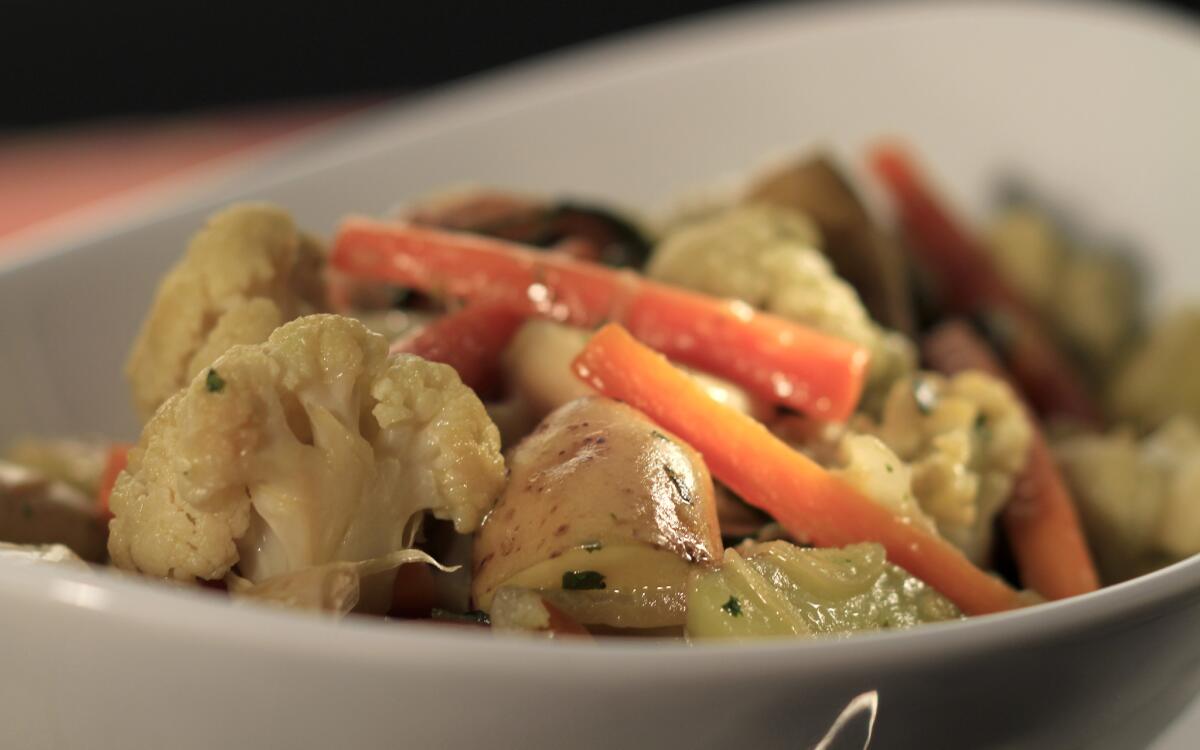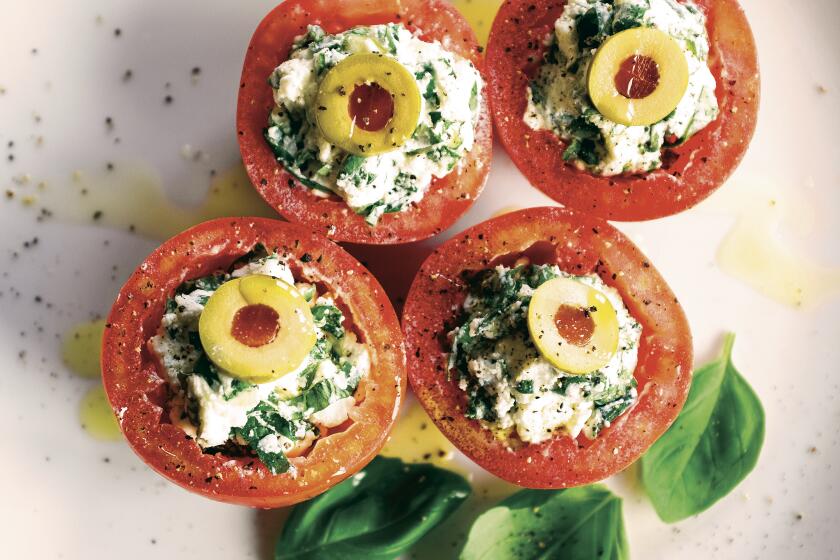Ragout of spring vegetables

- Share via
It was a lazy Sunday afternoon, and I’d just gotten home from the farmers market with, as usual, several bags of vegetables and no firm idea of what I was going to fix for dinner. So I did what I usually do in that situation -- started leafing through cookbooks.
I picked up the first one and -- I swear this is true -- it fell open to this very page:
“The subtle structure of harmonies drawn from a combination of tender young vegetables cooked (or, to be more accurate, sweated) together with butter (or olive oil or a combination) in a heavy, tightly covered vessel, each added, raw or precooked, at a specific moment corresponding to its own needs, the complexity of savory autonomies butter-bound in an amalgam of their own fragrances, accented by the caress of an herb or two -- a melting, shimmering balance of separateness and unity in fragile suspension....”
What’s unusual is not that I was turning to Richard Olney’s “Simple French Food” for guidance but that in a book I’ve read and re-read dozens of times, here was a section I didn’t recall.
It was on mixed vegetable stews, free-form affairs based on what you have on hand and what you feel like cooking, or as Olney so much more eloquently put it, their composition “depends on the season and on whim and, insofar as they are never twice identical, one must, each time, more or less ‘feel’ one’s way through the preparation.”
Poetic as the description might be, it does seem to imply a certain carelessness, or at least free-spiritedness. Rather than spelling out specific measures of set ingredients, what Olney gives in this recipe is a structure for a dish, a blueprint you can fit to your fancy.
Basic rules
A recipe written this way is open-ended; your enjoyment of it isn’t predicated upon being able to find an exact set of ingredients or following an exact set of instructions.
You’re going by instinct rather than by rote, and that’s how you become a real cook.
The basic rules for vegetable stews are few, but they are simple: You want some onions; you want whole cloves of garlic, preferably unpeeled; you want some lettuces or greens for moisture; and you want butter ... lots of butter.
Given this framework, you can sift through what is best at the market, finding those combinations of vegetables that will result in the harmonies Olney so expressively describes. Sort them according to their required cooking times (and whether they need to be pre-cooked -- dense vegetables such as potatoes almost certainly will).
After you have organized your thinking, the preparation is simple. I’ve made this with artichokes, spring onions and zucchini (Olney’s suggestion), but I’ve also experimented adding and subtracting fennel, fingerling potatoes, scarlet carrots and cauliflower in different combinations. I’ve even made it with bolted arugula from my garden. Waste not, want not.
The result is unfailingly delicious. Partly, of course, that’s because of the butter, almost a whole stick -- how could you go wrong? But mainly, it’s the slow stewing of the vegetables that results in a mellow harmony of flavors. Those whole unpeeled garlic cloves soften and release their perfume without a hint of harshness. Most times the only moisture added is from the greens as they warm.
And, of course, there is the butter, which melts into a creamy glaze, combining with the juices of the vegetables to make a delicately flavored sauce. I wish I could tell you that if you have trouble with your conscience you could leave some of it out, but when I tried that, it just wasn’t nearly as good. Butter is the binder here, of flavors as well as textures.
Mix and match
Something similar happened a week or so later. A photo of a simple dish of potatoes baked in parchment caught my eye when I was leafing through the gorgeous new collection of Elizabeth David recipes, “At Elizabeth David’s Table.” There was just something about the texture of the coarse salt on the potatoes and the wilted mint leaves languidly folded on top. (Yes, I know there were no photos in David’s books ... but trust me, this collection, put together by her longtime editor Jill Norman, is worth picking up.)
The recipe, which David credits to a turn-of-the-century book on paper-bag cookery by Nicolas Soyer, is loose to the point of being vague, as were so many of David’s recipes. Encouraged by this, I took even more liberties. In a half-dozen variations over a couple of weeks, I think only the paper remained from the original recipe.
Again, I used carrots, fennel, artichokes -- all of the vegetables that make this winter-turning-spring season great. I rubbed the vegetables in butter, as the original did, but I also used olive oil. I experimented with different herbs and used citrus zest to add a bright note.
Baking in paper (or aluminum foil -- it handles more easily and achieves the same result) and with olive oil results in flavors that are more distinct than stewing and don’t have that unifying gravity of butter holding them together. Still, they do share a certain sympathy.
My favorite combination was fingerling potatoes, fennel and artichokes, moistened with olive oil and scented with orange zest, garlic, fresh thyme and black olives. The potatoes are earthy but with just a hint of sweetness from the artichokes. The fennel picks up the orange and the thyme.
You can bake this in one big pouch, but two smaller pouches is easier to handle. Best of all, probably, is to make an individual serving pouch for each person at the table. One of my favorite things about baking in parchment is the moment when the package is opened and all the mingled scents arise in a big puff of steam.
It’s even better than it looked in the picture.
Prepare the vegetables: If the potatoes are very small, leave them whole. If they are walnut-sized, cut in half. If they are larger, cut in bite-sized pieces. The carrots should be about as wide as a pencil. If the carrots are very thin, leave them whole; otherwise, cut them lengthwise in halves or quarters. Break the cauliflower into florets. Cut the onion in half lengthwise and then into thin slices crosswise and add to the pan. Separate the garlic into individual cloves, but leave them unpeeled.
Steam the potatoes in a tightly covered pot over boiling water until tender, about 15 minutes, then drain.
While the potatoes are cooking, melt 2 tablespoons butter in a large saute pan over medium-low heat and add the onion and unpeeled garlic cloves to the pan. Cook, stirring occasionally, until the onions soften, about 5 minutes.
Reduce the heat to very low. Add the carrots and cauliflower to the pan, season with 1 teaspoon salt and scatter the arugula over the top. Cover tightly and cook very gently, stirring occasionally, until the carrots are tender, about 20 minutes. The arugula should exude enough moisture, but if the pan looks dry, add a tablespoon or two of water or white wine.
When the carrots are tender, transfer the steamed potatoes to the pan and stir gently to combine. Divide the remaining one-fourth cup of butter into 1-tablespoon chunks and add a piece or two at a time to the pan, stirring them into the vegetables to make a light sauce. Scatter the minced tarragon over the top and serve.
Get our Cooking newsletter
Get a taste of Los Angeles — and the world — with recipes and kitchen tricks from the L.A. Times’ Cooking newsletter.
You may occasionally receive promotional content from the Los Angeles Times.
















